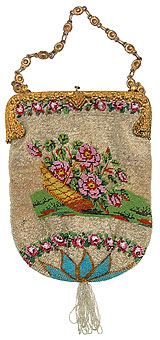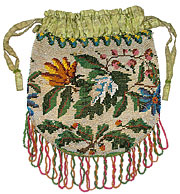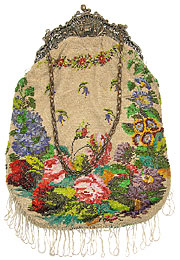THE LITTLE BEADED BAG
History's Favorite Fashion Accessory

By Sandy Levins ...| ...Feb. 24, 2005

CAMDEN, N.J. -- Through the years, it's been as small as a deck of cards and as large as a piece of luggage; as soft as velvet and as hard as Bakelite. It's been knitted, crocheted, embroidered, beaded and embossed. Hung from belts, slipped

|
| Photo: Hoag Levins |
Typical of elegant beaded purses of the mid-Victorian era is this one from the Historical Society's collection with a faux-gold frame. Click for larger view.
| over fingers and slung over shoulders. And, in one form or another, it has been with us since the time of the Crusades.
Called by many names, it's a fashion accessory used by both men and women since the Middle Ages: the pocketbook, the purse, the handbag, the reticule or, in today's world of the metrosexual, the man bag.
Beaded bags
But of all the bags that have waxed and waned in popularity over the years, perhaps none has earned its place in fashion, or been so cherished and sought after by collectors, as the little beaded bag.
As a prelude to Women's History Month in March, the Camden County Historical Society has been featuring a small front-lobby exhibit from the beaded bag holdings of its Historic Clothing and Accessories collection. The display makes clear why women have been so taken with such bags over the centuries. Combining the look and feel of a jeweled surface with the flexibility of fabric, they are works of art, statements of personal taste, and status symbols.
Popular for centuries
Beaded bags, whether handcrafted or commercially produced, have been in vogue in North America for well over 200 years and in Europe for much longer.
In the late 1300s, the English poet Geoffrey Chaucer described one in "The Miller's Tale," the story of a love affair between an Oxford student and a carpenter's wife. Of the female character he wrote: "By her belt hung a purse of leather tasseled with green and beaded with Italian beads."
Along with being museum pieces, beaded bags are highly prized in collectors' circles where they command high prices. The greatly coveted beaded works were of such value that, in the early 1800s, the patterns used to make them were jealously guarded as family secrets passed down through generations.
1000 beads per inch
Beaded bags from the middle of the 19th century were almost always made with very small, very fine beads -- up to 1000 beads/square inch can be found on bags dating

|
| Photo: Hoag Levins |
Beaded bags of the 18th and early 19th century most often were drawstring purses such as this one from the Society's collection. Click for larger view.
| before 1850. This type of fine beadwork produces a bag that appears tapestry-like.
Dating the beaded bag poses a dilemma for textile historians, since newer bags are often made with older beads. For instance, beads from the early 1800s might be used to decorate bags made in the 1920s. And while a bag's frame can sometimes provide clues to its age, not even this is foolproof. Only that rarity, a beaded bag signed and dated by its maker, provides reliable proof ... that is, if you can find one.
'Indispensables'
The earliest beaded bag was usually knitted in a drawstring style called a reticule, which also became known as an "indispensable" because it developed a universal popularity almost overnight. So popular was the reticule, it became an absolute "must" for fashionable ladies in 19th century Europe where the Empress Josephine, internationally known for her sense of fashion, carried a reticule with her at all times. Romantic figures, pastoral scenes, and flora and fauna became common themes rendered in the tiniest of beads.
Between 1820 and 1830, beaded bags supported by metal frames came into vogue. Coming primarily from France and Austria, the frames were made of everything from pinchbeck, an alloy of cooper and zinc made to look like gold, to tortoiseshell. Chains, often formed of decorative, ornate links, were attached to the frames.
20th-century fashion
By the early 20th century, beaded bags had become increasingly fashionable. Frames were more ornate -- made of solid gold, sterling silver, nickel, amber,

|
| Photo: Hoag Levins |
Intricately sculpted frames first appeared on beaded bags in the early 1800s and became a trademark of the elegant bags of the late Victorian period, such as this one from the Society's collection. Click for larger view.
| ivory, ormolu (an alloy of cooper and tin used to simulate gold) or celluloid -- and often heavily engraved or embossed, embellished with gemstones, filigree, pearls or enamel work.
Indian beading
The early 20th century also saw Native American beaded bags evolve into major fashion items. Unlike their predecessors, these bags were usually made of simple chamois and decorated with brightly colored beads. Patterns marketed by companies like McCall's allowed American women to make the bags at home using iron-on transfer patterns of original American Indian design. Detailed, step-by-step beading instructions were included in pattern books along with specific information about the size of the beads, their colors, and the numbers of each color needed to complete the project.
In testimony to their popularity, or maybe just proving "everything old is new again," beaded bags are still highly prized by today's fashion-conscious women. But instead of coming from France and Austria, contemporary beaded bags most often come from Asia. And although their patterns may be simpler than those of their predecessors, internationally famous designers like Judith Lieber, Prada and Badgley Mischka now commission beaded bags that sell for hundreds to thousands of dollars and are likely to become the hot collectibles and highly desired museum items of the future.
~ ~ ~
Sandy Levins is a Trustee and director of programming at the Camden County Historical Society.
~ ~ ~
|









